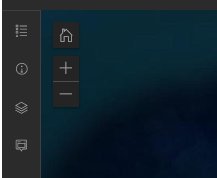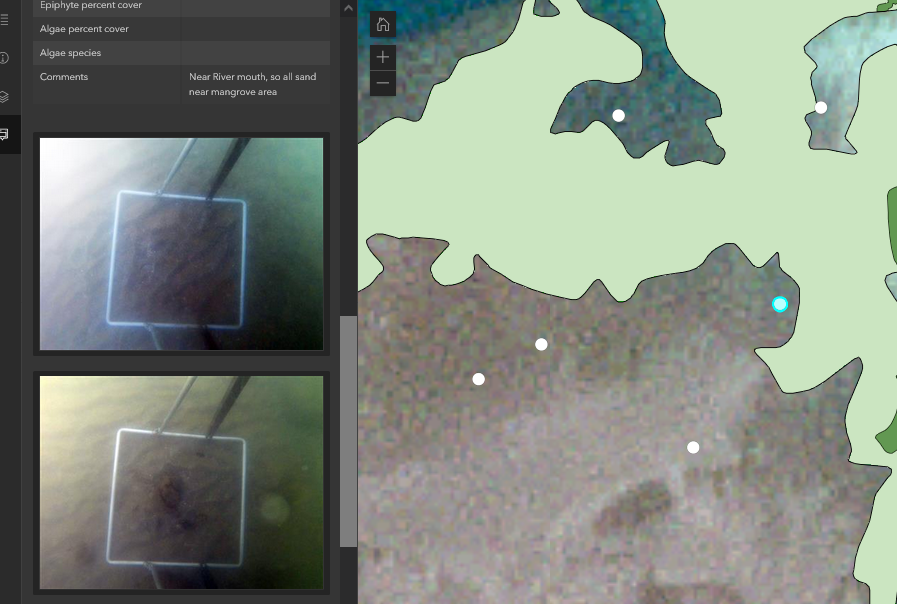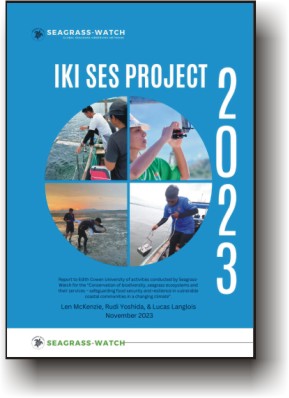Indonesia
IKI Seagrass Ecosystem Services Project
Mapping Results
Some field facts
Some
field facts

How to use map viewer
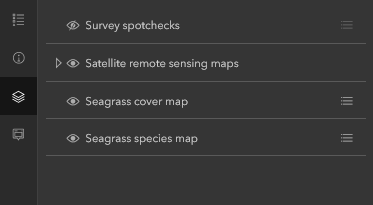 In Map Viewer, on the Contents (dark) toolbar (found on the left), select
In Map Viewer, on the Contents (dark) toolbar (found on the left), select ![]() (Layers) to display all the different map Layers.
(Layers) to display all the different map Layers.
The legend ![]() displays information about each layer that is visible at the current map scale. Not all layers contain legend information.
displays information about each layer that is visible at the current map scale. Not all layers contain legend information.
On the Contents (dark) toolbar, click (Legend). The legend displays information about each layer that is visible at the current map scale. Not all layers contain legend information.
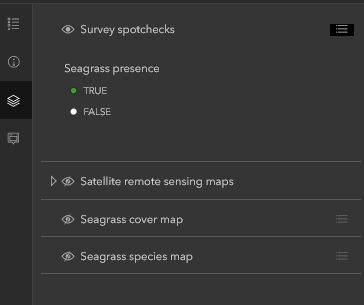 You do not need to show all map layers in the legend. For example, if the map focuses on seagrass distribution and extent for a region/country, you may want the legend to show only spotcheck symbols and not seagrass species and other reference data included in the map.
You do not need to show all map layers in the legend. For example, if the map focuses on seagrass distribution and extent for a region/country, you may want the legend to show only spotcheck symbols and not seagrass species and other reference data included in the map.
To hide a layer in the legend, do the following:
- Open the map with the legend in which you want to hide a layer.
- On the Contents (dark) toolbar, click Layers
 .
. - Browse to the layer you want to hide (turn off) or show (turn on).
- The layer visibility can then be turned on (Show layer
 ) or off (Hide layer
) or off (Hide layer  ) by clicking the eye symbol on the list.
) by clicking the eye symbol on the list.
Using the mouse wheel makes it easy to zoom and pan anytime you like without changing the tool you are currently using.
These shortcuts work in data view and layout view. In layout view, they apply to the page by default. You can hold down the SHIFT key and perform any shortcut to apply it to the data frame instead of the page (the active data frame in the case of rolling the mouse wheel, or the data frame you clicked in the case of clicking or dragging the mouse wheel).
| Mouse wheel action | ArcMap navigation function |
|---|---|
| Rolling wheel back and forth | Zooms in and out |
| Holding down CTRL and rolling | Zooms in and out but with finer increment; used for small adjustments |
| Clicking mouse wheel (or middle mouse button) | Centers map at location where you clicked |
| Holding down mouse wheel (or middle mouse button) and dragging | Pans |
| Holding down CTRL and clicking mouse wheel | Centers and zooms in at location you clicked |
| Holding down CTRL and dragging with the mouse wheel | Zooms in |
Northern Minahasa seagrass mapping results
Indonesia

Partner: Yapeka
Field Mapping: completed
Data Management: completed
QAQC/analysis: completed
Map Creation/Reporting: completed
Seagrass meadows in Northern Minahasa were assessed between the 18 January and 26 June 2023.
The surveys data from Indonesia North Minahasa was composed of a total of 462 individual points, of which 424 were collected from drop-camera, 8 from in situ sampling and 37 from Seagrass Spotter (sightings between 28 March 2019 to 31 July 2022).
A total of 372 points had seagrass present with a percentage cover ranging from 0.3 to 96.7 with an average of 30.2. A total of 9 different seagrass species were identified: Cymodocea rotundata, Cymodocea serrulata, Enhalus acoroides, Halophila minor, Halophila ovalis, Halodule pinifolia, Halodule uninervis, Syringodium isoetifolium, and Thalassia hemprichii. The most frequently encountered being E. acoroides, T. hemprichii and C. rotundata (49.8%, 32.9% and 4.9% respectively). The deepest field point assessed was 7 m, and the deepest seagrass was observed was 5 m (E. acoroides, H ovalis, T. hemprichii).
The extent of seagrass meadows within the Northern Minahasa Area of Interest (AOI) was between 129.2 to 221.1 ha (from remote sensing) with an additional 21.2 ha manually digitized from subtidal and/or turbid area where imagery would not enable reliable predictions.
The seagrass meadows of the western coast around Tarabitan, were composed of Enhalus acoroides dominated community close to shore and Thalassia hemprichii dominated community toward the reef edge (Figure 12a). Around Serei in the north, the seagrass meadows were predominantly Thalassia hemprichii communities with some small patches dominated by Syringodium isoetifolium and Enhalus acoroides . Moving southeast towards Bulutui, seagrass meadows were mostly dominated by Enhalus acoroides. Similar species assemblages are found in the more turbid coastal waters between the mainland and the islands of Pulau Tamperong and Pulau Resaan. Meadows adjacent to these islands were also mainly dominated by Enhalus acoroides and Thalassia hemprichii
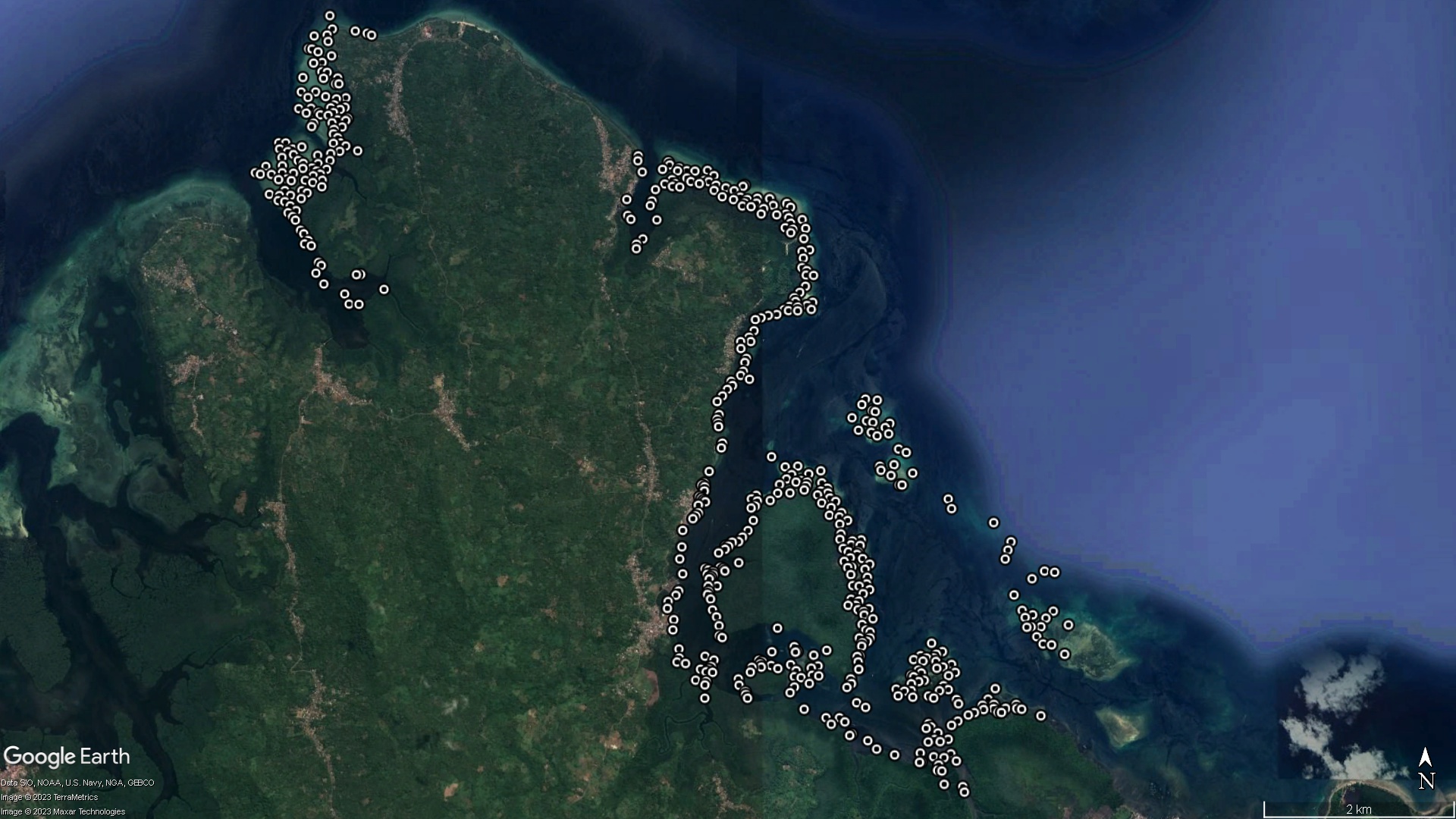
How the data was collected
Field validation points were spatially balanced and randomised within the Area of Interest (AOI). All data collected within the AOI was used to ensure mapping of all seagrass meadows present.
At each field validation point, teams conducted a spot-check using either Drop-Cam, in situ observation, or grab.
Photoquadrats were captured (except where only a grab sampler was used) during each spot-check. Photoquadrats were either geotagged or geolocated. Data collected from the photoquadrats (e.g. % cover and species) at each point and the Seagrass Spotter sightings were used to train and validate models for classification of satellite imagery.
Indonesia seagrass
It is generally acknowledged that eight genera and 13 species of seagrass inhabit Indonesian coastal waters. These include: Cymodocea serrulata, Cymodocea rotundata, Enhalus acoroides, Syringodium isoetifolium, Halodule pinifolia, Halodule uninervis, Halophila spinulosa, Halophila decipiens, Halophila ovalis, Thalassia hemprichii, Halophila minor , Thalassodendron ciliatum and Ruppia maritima. The R. maritima records are based on specimens at Herbarium Bogoriense collected from Ancol-Jakarta Bay and Pasir Putih-East Java, but have never been reported since (the development of Jakarta has destroyed the mangrove forest in Ancol).
A 14th species Halophila beccarii, although similarly known from a specimen at the Herbarium Bogoriense, was thought to exist in Indonesian waters, but there is no information on where it was collected and it has not been found in the field. No endemic species have been found.
Partnership

Working with YAPEKA, Seagrass-Watch (in partnership with IKI) aimed to collate rich but dispersed seagrass distribution information into an easily searchable, viewable and fully customisable map-based view for seagrass meadows of Northern Minihasa
This project is part of the International Climate Initiative (IKI). The Federal Ministry for the Environment, Nature Conservation and Nuclear Safety (BMU) supports this initiative on the basis of a decision adopted by the German Bundestag.

